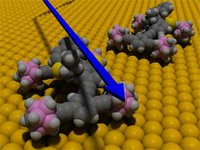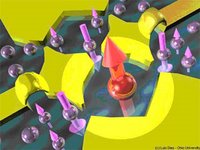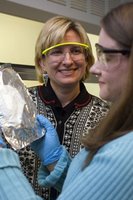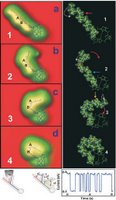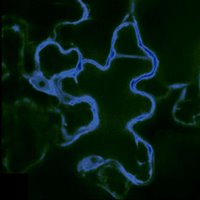 | Caption: In NIST's Einstein-de Haas experiment. |
A gyromagnetic effect discovered by Albert Einstein and Dutch physicist Wander Johannes de Haas--the rotation of an object caused by a change in magnetization--has been measured at micrometer-scale dimensions for the first time at the National Institute of Standards and Technology (NIST). The new method may be useful in the development and optimization of thin film materials for read heads, memories and recording media for magnetic data storage and spintronics, an emerging technology that relies on the spin of electrons instead of their charge as in conventional electronics.
The Einstein-de Haas effect was first observed in experiments reported in 1915, in which a large iron cylinder suspended by a glass wire was made to rotate by an alternating magnetic field applied along the cylinder's central axis. By contrast, the NIST experiments, described in the Sept. 18 issue of Applied Physics Letters,* measured the Einstein-de Haas effect in a ferromagnetic thin film only 50 nanometers thick deposited on a microcantilever--a tiny beam anchored at one end and projecting into the air. An alternating magnetic field induced changes in the magnetic state of the thin film, and the resulting torque bent the cantilever up and down by just a few nanometers.
Using a laser interferometer to measure the movements of the cantilever and comparing those data to changes in the magnetic state of the material, researchers were able to determine the "magnetomechanical ratio," or the extent to which the material twists in response to changes in its magnetic state. The magnetomechanical ratio is related to another important parameter, the "g-factor," a measure of the internal magnetic rotation of the electrons in a material in a magnetic field.
The magnetomechanical ratio and the g-factor are critical in understanding magnetization dynamics and designing magnetic materials for data storage and spintronics applications, but they are extremely difficult to determine accurately because of many potential complicating effects. The NIST experiments provide a proof-of-concept for using the Einstein-de Haas effect to determine the magnetomechanical ratio and the related g-factor in thin ferromagnetic films. The researchers note that a number of improvements are possible, such as operating the cantilever system in a vacuum to reduce the effects of any changes in temperature. ###
* T.M. Wallis, J. Moreland and P. Kabos. 2006. Einstein-de Haas effect in a NiFe film deposited on a microcantilever. Applied Physics Letters. Sept. 18.
Contact: Laura Ost laura.ost@nist.gov 301-975-4034 National Institute of Standards and Technology (NIST)
Technorati Tags: nanofibers or Nanoscientists and Nano or Nanotechnology and nanoparticles or Nanotech and nanotubes or nanochemistry and nanoscale or nanowires and Nanocantilevers or nanometrology and quantum mechanics or gyromagnetic effect and Wander Johannes de Haas or Albert Einstein
RELATED: Keywords Nanotech, science Sunday, September 24, 2006 Nanocar inventor named top nanotech innovator, Thursday, September 21, 2006 scientists tame tricky carbon nanotubes, Sunday, September 17, 2006 Double Quantum Dots Control Kondo Effect, Saturday, September 16, 2006 Biodegradable napkin, featuring nanofibers, may detect biohazards, Friday, September 08, 2006 Nanoscientists Create Biological Switch from Spinach Molecule, Sunday, September 03, 2006 Sugar metabolism tracked in living plant tissues, in real time, Wednesday, August 30, 2006 'Nanocantilevers' yield surprises critical for designing new detectors, Sunday, August 27, 2006 ion pump cooling hot computer chips, Thursday, August 24, 2006 Honeycomb Network Comprised of Anthraquinone Molecules, Sunday, August 20, 2006 siRNA shrink ovarian cancer tumors, Wednesday, August 16, 2006 Nanotechnology












